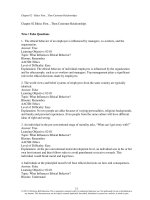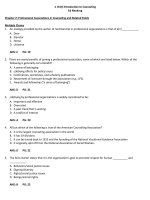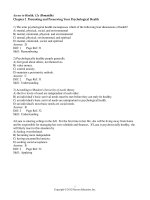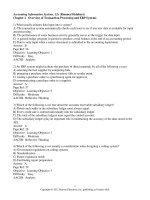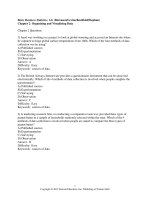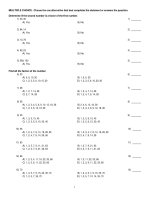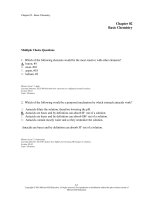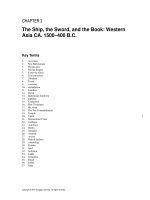Access to health 12th edition donatelle test bank
Bạn đang xem bản rút gọn của tài liệu. Xem và tải ngay bản đầy đủ của tài liệu tại đây (131.81 KB, 35 trang )
Access to Health, 12e (Donatelle)
Chapter 2 Promoting and Preserving Your Psychological Health
1) The term psychological health encompasses which of the following four dimensions of health?
A) mental, physical, social, and environmental
B) mental, emotional, physical, and environmental
C) mental, physical, environmental, and spiritual
D) mental, emotional, social, and spiritual
Answer: D
Diff: 1
Page Ref: 31
Skill: Remembering
2) Psychologically healthy people generally
A) feel good about others, not themselves.
B) value money.
C) control anxiety.
D) maintain a pessimistic outlook.
Answer: C
Diff: 2
Page Ref: 31
Skill: Understanding
3) According to Maslow's hierarchy of needs theory
A) the five levels of need are independent of each other.
B) an individual's basic survival needs must be met before they can truly be healthy.
C) an individual's basic survival needs are unimportant to psychological health.
D) an individual's most basic needs are social needs.
Answer: B
Diff: 2
Page Ref: 32
Skill: Understanding
4) Lana is entering college in the fall. For the first time in her life, she will be living away from home
and be responsible for managing her own schedule and finances. If Lana is psychosocially healthy, she
will likely react to this situation by
A) feeling overwhelmed.
B) becoming more independent.
C) having uncontrolled anxiety.
D) seeking social acceptance.
Answer: B
Diff: 2
Page Ref: 32
Skill: Applying
1
Copyright © 2012 Pearson Education, Inc.
5) Which of the following health dimensions includes your values, attitudes, and beliefs?
A) mental health
B) emotional health
C) social health
D) spiritual health
Answer: A
Diff: 2
Page Ref: 32
Skill: Understanding
6) Intensified feelings or complex patterns of reactions that we experience on a regular basis is/are called
A) conscience.
B) emotions.
C) objectivities.
D) actualizations.
Answer: B
Diff: 1
Page Ref: 32
Skill: Remembering
7) Social isolation can be a result of all of the following EXCEPT
A) inappropriate communications or actions.
B) emotionally charged responses.
C) appropriate emotional responses.
D) emotional turmoil.
Answer: C
Diff: 1
Page Ref: 33
Skill: Understanding
8) Self-actualization can best be described as
A) realizing you are in a safe place.
B) self-respect and accomplishment.
C) creativity, spirituality, and fulfillment of potential.
D) acceptance.
Answer: C
Diff: 1
Page Ref: 32
Skill: Understanding
9) Social health
A) includes the ability to develop social bonds.
B) means you have a lot of friends but never need to call on them for assistance.
C) is not necessary for achieving and maintaining physical health.
D) does not affect our interactions with people outside of our social network.
Answer: A
Diff: 2
Page Ref: 33
Skill: Understanding
2
Copyright © 2012 Pearson Education, Inc.
10) According to the text, which one of the keys to health and wellness embodies the ability to believe in
some force that gives meaning to life and a unifying sense of belonging?
A) Western religion
B) Eastern religion
C) subjective well-being
D) spirituality
Answer: D
Diff: 1
Page Ref: 34
Skill: Remembering
11) Which of the following is NOT an example of spiritual health?
A) organized religion
B) love of nature
C) love of material possessions
D) sense of connection to others
Answer: C
Diff: 2
Page Ref: 34
Skill: Understanding
12) Which of the following statements most accurately describes the role of families in the development
of psychosocial health?
A) Family life does not influence psychosocial health.
B) Children of dysfunctional families cannot develop psychosocial health.
C) Children raised in a nurturing environment are assured psychosocial health as adults.
D) A nurturing family will foster the development of psychosocial health but is not required.
Answer: D
Diff: 2
Page Ref: 35
Skill: Understanding
13) A family in which there is violence; physical, emotional, or sexual abuse; parental discord; or other
negative interactions
A) may psychologically damage family members.
B) helps children develop independence.
C) teaches sound coping skills.
D) accelerates development of self-worth.
Answer: A
Diff: 2
Page Ref: 35
Skill: Understanding
14) All of the following influence the development of your personality EXCEPT
A) heredity.
B) maturity.
C) culture.
D) experience.
Answer: B
Diff: 2
Page Ref: 36
Skill: Understanding
3
Copyright © 2012 Pearson Education, Inc.
15) Jaxon wants to get in better shape and lose 10 lbs. His belief about whether he can successfully
develop and maintain a fitness program is directly related to his level of
A) self-satisfaction.
B) self-mastery.
C) self-development.
D) self-efficacy.
Answer: D
Diff: 1
Page Ref: 36
Skill: Applying
16) Responding to life's challenges and frustrations with resiliency is a sign of
A) socioeconomic stability.
B) psychological health.
C) emotional adaptation.
D) environmental security.
Answer: B
Diff: 2
Page Ref: 31
Skill: Understanding
17) After a failed marriage, loss of a job, a chronic illness, and bankruptcy, Nathan's demeanor has
developed into a pattern known as
A) learned helplessness.
B) negative expressiveness.
C) depressive helplessness.
D) hopeless pattern behavior.
Answer: A
Diff: 2
Page Ref: 36
Skill: Understanding
18) Maslow ranks human needs in the following ascending order:
A) esteem, survival, social, security, self-actualization
B) survival, security, social, esteem, self-actualization
C) self-actualization, esteem, social, security, survival
D) survival, social, security, esteem, self-actualization
Answer: B
Diff: 1
Page Ref: 33
Skill: Remembering
19) Martin Seligman's principle of ________ helps to counteract learned helplessness and foster more
overall positive development through improved mental health practices.
A) learned helpfulness
B) learned pessimism
C) learned optimism
D) learned mindfulness
Answer: C
Diff: 2
Page Ref: 36
Skill: Understanding
4
Copyright © 2012 Pearson Education, Inc.
20) Which of the following is NOT considered a personality trait related to psychological well-being?
A) agreeableness
B) introversion
C) conscientiousness
D) emotional stability
Answer: B
Diff: 1
Page Ref: 37
Skill: Understanding
21) The degree and nature of your interpersonal contacts defines
A) social support.
B) social bonds.
C) social interaction.
D) spiritual health.
Answer: B
Diff: 1
Page Ref: 33
Skill: Remembering
22) Wendy spent her entire first semester at East State University suffering from one little illness after
another. She felt overwhelmed by the amount of schoolwork she had to accomplish and did not earn all
A's as she did in high school. Her best friend from high school, Susie, attended West State University
and enjoyed a wonderfully exciting and successful first semester. Which of the following statements
best summarizes their situation?
A) Wendy should have attended West State University as it clearly is a better school.
B) Susie must have lived in a better residence hall which allowed her to stay healthy making it easier for
Susie to do well in her schoolwork.
C) Wendy is not as academically prepared for college even though she and Susie took all of the same
college prep classes in high school.
D) Susie has resiliency which enables her to cope with the challenges of university life.
Answer: D
Diff: 2
Page Ref: 38
Skill: Analyzing
23) Which of the following is NOT considered a central component of subjective well-being?
A) satisfaction with present life
B) relative presence of positive emotions
C) relative absence of negative emotions
D) feelings of inner connectedness
Answer: D
Diff: 2
Page Ref: 38
Skill: Understanding
5
Copyright © 2012 Pearson Education, Inc.
24) New studies suggest that happiness may
A) reduce the risk for cardiovascular disease.
B) cause an irregular heart rate.
C) worsen cardiovascular disease severity.
D) decrease the blood level of C-reactive protein.
Answer: A
Diff: 2
Page Ref: 37
Skill: Understanding
25) Which of the following students is LEAST likely to have subjective well-being?
A) Joe's father works in the coal mines and his mom stays at home raising his 3 little sisters. Joe, a
sophomore, lives at home and does odd jobs around town to help make ends meet. Joe is proud to be the
first in his family to attend college.
B) Jim's father is a partner in a prestigious law firm; his mother stays at home raising his 3 little sisters.
Jim, a sophomore, lives in a nice off-campus apartment because those geeky freshmen in the residence
halls really get on his nerves.
C) John, the team's starting quarterback, is facing the toughest team in the conference but is excited
because he is sure his team will play a great game.
D) Jacob was the team's starting quarterback last year and is really disappointed about being moved to a
back-up position. He still goes to every practice and game, giving his best effort, and is really excited
about how well the team is doing this year.
Answer: B
Diff: 3
Page Ref: 38
Skill: Analyzing
26) Which statement is true about mental health?
A) Mental health problems can affect all age groups and in fact are prevalent among college students.
B) Mental illness is always serious and easily recognized.
C) Mental disorders very rarely cause disability for persons between the ages of 15 and 44 years.
D) Mental illness is actually caused only by biochemical dysfunction in the brain.
Answer: A
Diff: 3
Page Ref: 39
Skill: Understanding
27) Which of the following is the most common chronic mood disorder?
A) major depression
B) dysthymic disorder
C) premenstrual syndrome
D) bipolar disorder
Answer: A
Diff: 1
Page Ref: 40
Skill: Remembering
6
Copyright © 2012 Pearson Education, Inc.
28) Erin is concerned because she has been feeling discouraged by life and her circumstances, including
feelings of guilt and worthlessness. She also expresses overall feelings of hopelessness, sadness, and
despair. On the basis of her symptoms, what might she be suffering from?
A) paranoia
B) anxiety disorder
C) schizophrenia
D) depression
Answer: D
Diff: 2
Page Ref: 40
Skill: Analyzing
29) The symptoms of post-traumatic stress disorder (PTSD) include
A) desire to relive and change the event outcome.
B) retelling traumatic event details.
C) intrusive recollections of the traumatic events, such as nightmares.
D) a complete loss of memory about the event.
Answer: C
Diff: 2
Page Ref: 46
Skill: Understanding
30) Lisa seems to be on an emotional roller coaster. She goes from one extreme emotion to another,
from euphoric to depressive. Lisa is most likely suffering from
A) phobia.
B) panic disorder.
C) depression.
D) bipolar disorder.
Answer: D
Diff: 1
Page Ref: 43
Skill: Analyzing
31) Alex has invited a group of his classmates to meet with school security services to discuss student
involvement in improving campus safety. Alex's group is an example of
A) volunteerism.
B) collective efficacy.
C) subjective well-being.
D) learned optimism.
Answer: B
Diff: 3
Page Ref: 35
Skill: Applying
32) Which is NOT a characteristic of the manic phase of bipolar disorder?
A) outgoing and talkative
B) quiet and reserved
C) abundant energy
D) overactive
Answer: B
Diff: 1
Page Ref: 43
Skill: Understanding
7
Copyright © 2012 Pearson Education, Inc.
33) Which of the following factors do NOT trigger episodes of bipolar disorder?
A) genetic
B) biological
C) social
D) environmental
Answer: C
Diff: 1
Page Ref: 43
Skill: Remembering
34) Which statement is true about depression in men?
A) Men are more likely to admit they are depressed than women are.
B) Depressed men personify the hopeless, helpless, downtrodden male.
C) Risk of death from heart disease is the same in depressed men and women.
D) Suicide rates among depressed men are four times those of depressed women.
Answer: D
Diff: 2
Page Ref: 42
Skill: Understanding
35) Which of the following is NOT an anxiety disorder?
A) obsessive-compulsive disorder
B) panic disorder
C) post-traumatic stress disorder
D) schizophrenia
Answer: D
Diff: 1
Page Ref: 44
Skill: Remembering
36) Heather is always tired, tense, and irritable with everyone. She has difficulty concentrating and
sleeping. She's had these symptoms for at least the last six months. Her behavior is most characteristic of
A) acrophobia.
B) bipolar disorder.
C) panic disorder.
D) generalized anxiety disorder.
Answer: D
Diff: 2
Page Ref: 44-45
Skill: Understanding
37) Lynn has a panic disorder and experiences shortness of breath, chest pain with a rapid heartbeat,
stomach pains, and a sense of doom when she enters an elevator. Recently she has been avoiding any
building with an elevator because she is afraid she will have a panic attack and not be able to escape or
get the care she needs. Lynn most likely has developed
A) a social phobia.
B) post-tramatic stress disorder (PTSD).
C) agoraphobia.
D) generalized anxiety disorder.
Answer: C
Diff: 3
Page Ref: 45
Skill: Analyzing
8
Copyright © 2012 Pearson Education, Inc.
38) Denise often experiences sudden bursts of disabling terror called
A) nervousness.
B) panic attacks.
C) phobias.
D) stress.
Answer: B
Diff: 2
Page Ref: 45
Skill: Remembering
39) Researchers suspect panic attacks may be caused by
A) a neurological imbalance.
B) chronic depression.
C) heredity, stress, and certain biochemical factors.
D) a heart condition.
Answer: C
Diff: 1
Page Ref: 45
Skill: Remembering
40) Anthony served time in prison for selling drugs to finance his college education. Several years later,
after settling down with his career and own family, he began to constantly worry that his children would
find out about his "dirty" past and lose respect and love for him. Anthony found himself taking as many
as 10 showers a day even though he realized his senseless behavior would not wash away his past.
Anthony was most likely suffering from
A) generalized anxiety disorder.
B) obsessive-compulsive disorder.
C) social phobia.
D) post-traumatic stress disorder.
Answer: B
Diff: 3
Page Ref: 45
Skill: Understanding
41) Greg suffers from a persistent and unreasonable fear of snakes. He panics even if he sees one on
television. Greg is most likely suffering from
A) anxiety.
B) panic.
C) a phobia.
D) hysteria.
Answer: C
Diff: 2
Page Ref: 45
Skill: Understanding
42) Someone with a social phobia would fear
A) high places.
B) public gatherings.
C) driving at night.
D) snakes and spiders.
Answer: B
Diff: 2
Page Ref: 45
Skill: Understanding
9
Copyright © 2012 Pearson Education, Inc.
43) Which of the following is NOT commonly considered a source of anxiety disorders?
A) biology
B) environment
C) social/cultural roles
D) OTC drugs
Answer: D
Diff: 2
Page Ref: 46
Skill: Remembering
44) Which of the following is MOST characteristic of anxiety disorders?
A) spontaneous feelings of not belonging
B) socially distressing behaviors
C) persistent feelings of threat and worry
D) inability to concentrate
Answer: C
Diff: 1
Page Ref: 44
Skill: Remembering
45) Which is NOT a true statement regarding self-mutilation?
A) Self-mutilation is a coping mechanism used to deal with negative emotions.
B) Poverty and low academic ability are always risks for self-mutilation.
C) A significant number of self-mutilators were abused as children.
D) The goal of treatment for self-mutilation is to ignore the feelings that prompt self-mutilation.
Answer: B
Diff: 2
Page Ref: 47
Skill: Understanding
46) Seasonal affective disorder is associated with
A) malfunction of the thyroid gland.
B) lack of social interaction.
C) too many external stimuli.
D) reduced exposure to sunlight.
Answer: D
Diff: 2
Page Ref: 43
Skill: Remembering
47) Which of the following is NOT often used in treating seasonal affective disorder?
A) diet change
B) increased exercise
C) decreased exercise
D) stress management
Answer: C
Diff: 2
Page Ref: 43
Skill: Understanding
10
Copyright © 2012 Pearson Education, Inc.
48) Michael experiences hallucinations and changes in his behaviors, movements, and emotions
unpredictably and radically. He has been diagnosed with schizophrenia. All of the following could help
Michael lead a normal life EXCEPT
A) social support and public understanding.
B) pyschotherapy and medication.
C) psychoanalysis.
D) family counseling and assistance.
Answer: C
Diff: 2
Page Ref: 48
Skill: Understanding
49) Which of the following statements about schizophrenia is true?
A) It is caused by an environmental factor.
B) It is a biological disease of the brain.
C) It is caused by abnormal family interaction in childhood.
D) It results from early childhood traumas.
Answer: B
Diff: 2
Page Ref: 47
Skill: Understanding
50) Treatment for schizophrenia includes all of the following EXCEPT
A) light therapy.
B) psychotherapy.
C) medication.
D) hospitalization.
Answer: A
Diff: 2
Page Ref: 48
Skill: Remembering
51) Which of the following statements about suicide is true?
A) It is the leading cause of death for people 15-24.
B) College students are more likely to attempt suicide than the general population.
C) College students now account for nearly 98% of all suicides.
D) Suicide usually occurs unpredictably.
Answer: B
Diff: 1
Page Ref: 48
Skill: Remembering
52) Which of the following is NOT a risk factor for suicide?
A) suicide by a close friend or family member
B) excessive substance use or abuse
C) loss of a loved one
D) multiple minor illnesses
Answer: D
Diff: 1
Page Ref: 48
Skill: Remembering
11
Copyright © 2012 Pearson Education, Inc.
53) Dan has been experiencing mood swings and has been participating in extremely risky behavior
claiming that he does not care what happens to him. Dan's characteristics are warning signals for
A) panic disorder.
B) affective disorder.
C) schizophrenia.
D) suicide.
Answer: D
Diff: 2
Page Ref: 48
Skill: Understanding
54) All of the following actions are recommended to prevent suicide EXCEPT
A) take all threats seriously, don't just brush them off.
B) use the "tough love" approach when empathy is not effective.
C) ask directly, "Are you thinking about hurting or killing yourself?" Let them know you care.
D) listen carefully, and empathize and sympathize without acting shocked by what they say.
Answer: B
Diff: 1
Page Ref: 49
Skill: Applying
55) Approximately what ratio of Americans seeks help from mental health professionals at some point
in their lives?
A) one in twenty
B) one in ten
C) one in five
D) one in three
Answer: C
Diff: 2
Page Ref: 49
Skill: Remembering
56) Which of the following is NOT a major reason for increasing numbers of Americans seeking
professional help for psychosocial problems?
A) dysfunctional families
B) increasing use of technology
C) breakdown in support systems
D) increasing societal expectations of individuals
Answer: B
Diff: 1
Page Ref: 49
Skill: Understanding
57) Which of the following is a way to help yourself if you are depressed?
A) Don't lower your goals; reaching your goals will always make you feel better about yourself.
B) Tackle the large tasks first as your sense of accomplishment will improve your mood.
C) Do things that are enjoyable and make you feel better such as exercising or going out with a friend.
D) Acknowledge your depression so you will immediately feel much better.
Answer: C
Diff: 2
Page Ref: 50
Skill: Applying
12
Copyright © 2012 Pearson Education, Inc.
58) If you think you have a psychological problem and need treatment, which of the following should
you do first?
A) Discuss it with no one.
B) Schedule a thorough examination.
C) Interview three different psychiatrists.
D) Try to "just get over it."
Answer: B
Diff: 1
Page Ref: 50
Skill: Remembering
59) David's therapist gave him a prescription for an antidepressant. What type of mental health
professional does he go to?
A) psychologist
B) psychiatrist
C) psychiatric social worker
D) social counselor
Answer: B
Diff: 2
Page Ref: 52
Skill: Understanding
60) According to Maslow's hierarchy of needs theory, failure to meet one of the lower levels of needs
will not interfere with a person's ability to reach self-actualization.
Answer: FALSE
Diff: 1
Page Ref: 32
Skill: Understanding
61) Psychological distress among college students is a major contributor to unhealthy behavior.
Answer: TRUE
Diff: 2
Page Ref: 31
Skill: Understanding
62) Psychological health encompasses the mental, emotional, social, and spiritual dimensions of health.
Answer: TRUE
Diff: 2
Page Ref: 32
Skill: Understanding
63) The psychologically healthy person becomes easily frustrated by stressful situations.
Answer: FALSE
Diff: 2
Page Ref: 32
Skill: Understanding
64) The term emotional health is often used to describe the "thinking" part of psychological health.
Answer: FALSE
Diff: 1
Page Ref: 32
Skill: Understanding
13
Copyright © 2012 Pearson Education, Inc.
65) Social and intellectual health are unaffected by emotional health.
Answer: FALSE
Diff: 1
Page Ref: 33
Skill: Understanding
66) The terms "spirituality" and "religion" may be used interchangeably.
Answer: FALSE
Diff: 2
Page Ref: 34
Skill: Understanding
67) Children raised in a nurturing, happy environment are assured psychological health as adults.
Answer: FALSE
Diff: 1
Page Ref: 35
Skill: Understanding
68) Personality is inborn and can never be changed.
Answer: FALSE
Diff: 1
Page Ref: 36-37
Skill: Understanding
69) Children from dysfunctional families may attain psychological health.
Answer: TRUE
Diff: 2
Page Ref: 35
Skill: Understanding
70) The communities to which an individual belongs have no impact on psychological health.
Answer: FALSE
Diff: 2
Page Ref: 35
Skill: Understanding
71) An individual with high self-efficacy would have confidence in their ability to change their eating
habits and incorporate healthier choices.
Answer: TRUE
Diff: 2
Page Ref: 36
Skill: Applying
72) Resiliency is a personality trait that is unrelated to psychological wellness.
Answer: FALSE
Diff: 1
Page Ref: 38
Skill: Remembering
73) Self-esteem includes taking pride in your accomplishments.
Answer: TRUE
Diff: 2
Page Ref: 36
Skill: Understanding
14
Copyright © 2012 Pearson Education, Inc.
74) Attention-deficit/hyperactive disorder (ADHD) diagnosed in childhood resolves by age 21 years.
Answer: FALSE
Diff: 1
Page Ref: 41
Skill: Remembering
75) An individual who continually experiences failure may eventually develop learned helplessness.
Answer: TRUE
Diff: 2
Page Ref: 36
Skill: Applying
76) The transition from childhood to adulthood is difficult for individuals who have learned to evaluate
their emotional responses.
Answer: FALSE
Diff: 1
Page Ref: 37
Skill: Remembering
77) To achieve overall subjective well-being one must learn to be happy all of the time.
Answer: FALSE
Diff: 2
Page Ref: 38
Skill: Remembering
78) Happiness can be enhanced by acknowledging and appreciating good things that happen.
Answer: TRUE
Diff: 1
Page Ref: 38
Skill: Understanding
79) People with ADHD are hyperactive and distracted most of the time, but it rarely has any effect on
their home, school, or work life.
Answer: FALSE
Diff: 2
Page Ref: 41
Skill: Understanding
80) Post-traumatic stress disorder (PTSD) develops only in someone who has witnessed war.
Answer: FALSE
Diff: 1
Page Ref: 45
Skill: Understanding
81) Laughter may lower an individual's risk of cardiovascular disease.
Answer: TRUE
Diff: 1
Page Ref: 38
Skill: Applying
82) Depression is the most common anxiety disorder.
Answer: FALSE
Diff: 1
Page Ref: 40
Skill: Remembering
15
Copyright © 2012 Pearson Education, Inc.
83) According to the American Journal of Psychiatry, children of a depressed parent have an increased
risk of psychosocial illness or impairment.
Answer: TRUE
Diff: 1
Page Ref: 42
Skill: Remembering
84) Social anxiety disorders involve persistent fears and avoidance of being in social situations.
Answer: TRUE
Diff: 1
Page Ref: 45
Skill: Understanding
85) The majority of individuals with borderline personality disorder (BPD) engage in risky behavior.
Answer: TRUE
Diff: 1
Page Ref: 46
Skill: Understanding
86) Schizophrenia is treatable but not curable with current treatment methods.
Answer: TRUE
Diff: 1
Page Ref: 48
Skill: Remembering
87) Suicide most frequently occurs spontaneously and without warning.
Answer: FALSE
Diff: 1
Page Ref: 662
Skill: Understanding
88) A person who has been depressed for a long time is at an increased risk for committing suicide.
Answer: TRUE
Diff: 1
Page Ref: 48
Skill: Understanding
89) Psychoanalysts are trained as medical doctors and can prescribe medications.
Answer: FALSE
Diff: 1
Page Ref: 52
Skill: Remembering
16
Copyright © 2012 Pearson Education, Inc.
Match the following.
A)
B)
C)
D)
E)
agreeableness
emotional stability
openness to experience
conscientiousness
extroversion
90) The ability to adapt to a social situation and demonstrate assertiveness as well as power or
interpersonal involvement
Answer: E
Diff: 1
Page Ref: 37
Skill: Remembering
91) The ability to conform, be likeable, and demonstrate friendly compliance as well as love
Answer: A
Diff: 1
Page Ref: 37
Skill: Remembering
92) The ability to demonstrate curiosity and independence
Answer: C
Diff: 1
Page Ref: 37
Skill: Remembering
93) The ability to maintain social control
Answer: B
Diff: 1
Page Ref: 37
Skill: Remembering
94) The qualities of being dependable, demonstrating self-control and discipline, and having a need to
achieve
Answer: D
Diff: 1
Page Ref: 37
Skill: Remembering
17
Copyright © 2012 Pearson Education, Inc.
Match the following.
A)
B)
C)
D)
E)
esteem needs
survival needs
self-actualization
social needs
security needs
95) Creativity, spirituality, and fulfillment
Answer: C
Diff: 1
Page Ref: 34
Skill: Remembering
96) Self-respect, respect for others, and accomplishments
Answer: A
Diff: 1
Page Ref: 34
Skill: Remembering
97) Shelter, safety, and protection
Answer: E
Diff: 1
Page Ref: 34
Skill: Remembering
98) Belonging, affection, and acceptance
Answer: D
Diff: 1
Page Ref: 34
Skill: Remembering
99) Food, water, sleep, exercise, and sexual expression
Answer: B
Diff: 1
Page Ref: 34
Skill: Remembering
18
Copyright © 2012 Pearson Education, Inc.
Match the following.
A) schizophrenia
B) obsessive-compulsive disorder (OCD)
C) panic attack
D) generalized anxiety disorder (GAD)
100) A constant sense of worry causing restlessness, irritability, and difficulty concentrating
Answer: D
Diff: 1
Page Ref: 44-45
Skill: Remembering
101) Severe anxiety reaction; symptoms may mimic a heart attack
Answer: C
Diff: 1
Page Ref: 45
Skill: Remembering
102) Mental illness characterized by irrational behavior, hallucinations, and difficulty functioning in
society
Answer: A
Diff: 1
Page Ref: 46
Skill: Remembering
103) Recurring, unwanted thoughts often associated with repetitive, hard-to-resist behavior
Answer: B
Diff: 1
Page Ref: 45
Skill: Remembering
104) Interactions with others, the ability to use social supports, and the ability to adapt to different
situations is called ________ health.
Answer: social
Diff: 1
Page Ref: 33
Skill: Understanding
105) The interplay of physiological arousal, feelings, cognitive processes, and behavioral reactions is
known as ________.
Answer: emotions
Diff: 2
Page Ref: 32 - 33
Skill: Remembering
106) The level of closeness and attachment that we develop with other individuals is known as
________ bonds.
Answer: social
Diff: 2
Page Ref: 34
Skill: Remembering
19
Copyright © 2012 Pearson Education, Inc.
107) Paranoid, narcissistic, and borderline ________ disorders are characterized by socially distressing
behaviors.
Answer: personality
Diff: 1
Page Ref: 46
Skill: Understanding
108) Characteristics of ________ families include violence or sexual, physical, or emotional abuse.
Answer: dysfunctional
Diff: 1
Page Ref: 35
Skill: Remembering
109) Persistent sadness, despair, and hopeless are indicative of a chronic ________ disorder.
Answer: mood
Diff: 1
Page Ref: 40
Skill: Understanding
110) Psychosocially healthy people who create and maintain a network of friends and family are likely
to have strong ________ supports.
Answer: social
Diff: 2
Page Ref: 34
Skill: Remembering
111) Learned ________ is a pattern of responding in which a person gives up and fails to take any action
to help themself.
Answer: helplessness
Diff: 1
Page Ref: 36
Skill: Remembering
112) The ________ step in defeating depression is to recognize it.
Answer: first
Diff: 1
Page Ref: 50
Skill: Remembering
113) Seligman's other pattern of responding in which people teach themselves to be more optimistic is
called learned ________.
Answer: optimism
Diff: 1
Page Ref: 36
Skill: Remembering
114) The ability to adapt to change and deal with stressful events in healthy ways is called ________.
Answer: resiliency
Diff: 1
Page Ref: 37
Skill: Remembering
115) The term ________ health is often referred to as intellectual health.
Answer: mental
Diff: 1
Page Ref: 32
Skill: Understanding
20
Copyright © 2012 Pearson Education, Inc.
116) The ability to conform, be likeable, and demonstrate friendly compliance and love is called
________.
Answer: agreeableness
Diff: 1
Page Ref: 37
Skill: Remembering
117) Negative stereotypes about groups of people are called ________.
Answer: stigmas
Diff: 1
Page Ref: 50
Skill: Remembering
118) Psychoneuroimmunology (PNI) is the study of the interaction of psychosocial factors, the central
nervous system, behavior, and the ________ system.
Answer: immune
Diff: 2
Page Ref: 37
Skill: Remembering
119) Satisfaction with present life, relative presence of positive emotions, and relative absence of
negative emotions are three components of ________ well-being.
Answer: subjective
Diff: 1
Page Ref: 38
Skill: Understanding
120) Sadness and despair are the main symptoms of ________.
Answer: depression
Diff: 2
Page Ref: 40
Skill: Understanding
121) Anxiety disorders are the number one ________ health problem in the United States.
Answer: mental
Diff: 1
Page Ref: 44
Skill: Remembering
122) A ________ is a deep and persistent fear of a specific object, activity, or situation that results in a
compelling desire to avoid the source of the fear.
Answer: phobia
Diff: 1
Page Ref: 45
Skill: Remembering
123) The type of medication used to treat ADHD, which is often abused to enhance performance, are
called ________.
Answer: stimulants
Diff: 1
Page Ref: 53
Skill: Remembering
21
Copyright © 2012 Pearson Education, Inc.
124) The inability to sort out incoming stimuli and make appropriate responses is characteristic of
________.
Answer: schizophrenia
Diff: 2
Page Ref: 46
Skill: Understanding
125) A ________ is a licensed physician who specializes in treating mental and emotional disorders.
Answer: psychiatrist
Diff: 1
Page Ref: 52
Skill: Remembering
126) Generalized ________ disorder interferes with the function and enjoyment of life.
Answer: anxiety
Diff: 1
Page Ref: 44-45
Skill: Understanding
127) A ________ is a person with a Ph.D. in counseling or clinical psychology.
Answer: psychologist
Diff: 1
Page Ref: 52
Skill: Remembering
128) A therapist who specializes in helping patients recall and resolve traumatic childhood memories is
called a ________.
Answer: psychoanalyst
Diff: 2
Page Ref: 52
Skill: Remembering
129) Compare and contrast psychologically healthy people with their "unhealthy" counterparts. What
differences do you notice in psychosocially healthy people?
Answer: (noted characteristics of psychosocially healthy people include)
1. They feel good about themselves; are realistic; respect self.
2. They feel comfortable with other people; can love and be loved.
3. They control tension and anxiety; internal locus of control.
4. They meet the demands of life; internal locus of control; flexible; adapt.
5. They curb hate and guilt; reach out to help others.
6. They maintain a positive outlook; optimistic.
7. They value diversity.
8. They respect nature.
Diff: 3
Page Ref: 31-32
Skill: Analyzing
130) Compare and contrast the concepts of "mental health" and "emotional health". Give examples of
each.
Answer: Mental health refers to the thinking part of psychosocial health while emotional health refers to
the feeling part of psychosocial health. Examples will vary.
Diff: 3
Page Ref: 32-33
Skill: Analyzing
22
Copyright © 2012 Pearson Education, Inc.
131) Define social bonds and social supports as they relate to social health.
Answer: Social bonds reflect the general degree and nature of our interpersonal contacts and
interactions. The six main functions are to provide intimacy, feelings of belonging, opportunities for
giving/receiving nurturance, reassurance of one's worth, assistance and guidance, and provide advice.
Social supports refer to the relationships that bring positive benefits to the individual. They can be
intangible (emotional support, encouragement) or tangible (housing, money).
Diff: 3
Page Ref: 34
Skill: Understanding
132) Define Seligman's learned optimism as a counterpart to learned helplessness.
Answer: Just as we learn to be helpless, we can teach ourselves to be optimistic. Learned optimism
research provides growing evidence for the central place of mental health in overall positive
development.
Diff: 2
Page Ref: 36
Skill: Remembering
133) Describe three of the six personality traits which psychosocially healthy people possess.
Answer: (any three of the following)
1. Extroversion - ability to adapt to a social situation and demonstrate assertiveness, power, and/or
interpersonal involvement.
2. Agreeableness - ability to conform, be likable, and demonstrate friendly compliance and love.
3. Openness to experience - willingness to demonstrate curiosity and independence or inquiring intellect.
4. Emotional stability - ability to maintain social control.
5. Conscientiousness - being dependable and demonstrating self-control, discipline, and a need to
achieve.
6. Resiliency - the ability to adapt to change and stressful events in healthy and flexible ways.
Diff: 2
Page Ref: 37
Skill: Understanding
134) List five ways to improve your self-efficacy and self-esteem. For each one, give an example of
how you can use this concept specifically to improve your own self-esteem.
Answer: Don't focus on faults, squelch the inner critic; see mistakes as opportunities to know yourself
better; accept a compliment positively; focus on the positive; don't compare yourself with others; give
yourself time to feel good; spend time with a supportive person; count your blessings.
Diff: 2
Page Ref: 36
Skill: Applying
135) What characteristics do you feel are most important in a support group? Describe ways in which
that group can help an individual effectively build self-esteem.
Answer: An effective support group must make you feel good about yourself and must force you to take
an honest look at your actions and choices. Characteristics will vary. They may include dependability,
ability to nurture, nonjudgmental nature, caring, compassion, etc. Support groups offer acceptance,
approval, and encouragement to the individual in order to boost self-esteem.
Diff: 3
Page Ref: 49
Skill: Evaluating
23
Copyright © 2012 Pearson Education, Inc.
136) What are the three central components which define subjective well-being?
Answer:
1. Satisfaction with present life
2. Relative presence of positive emotions
3. Relative absence of negative emotions
Diff: 2
Page Ref: 38
Skill: Remembering
137) List and describe three reasons proposed for the disproportionate number of women suffering from
depression as compared to men.
Answer:
Biological: Women appear to be at greater risk for depression when their hormone levels change
significantly; men's hormones are more stable throughout life.
Psychological: It is theorized that women are under more stress and stress precedes depression.
Social: There are gender differences in coping strategies.
Diff: 2
Page Ref: 42
Skill: Analyzing
138) The prevalence of mental health problems on college campuses appear to be increasing in number.
What factors may be contributing to this trend?
Answer:
1. More students are seeking help.
2. Early treatment may allow more previously diagnosed students to function well enough to attend
colleges.
Diff: 2
Page Ref: 39
Skill: Evaluating
139) Describe two campus mental health initiatives and the mental health issues they were designed to
address.
Answer: (any two of the following)
1. Counseling / therapist support 24/7
2. "Student Leave" for those at highest risk for suicide
3. Workshops on various stress management strategies
4. Classes on stress management and coping
5. New-student orientations to help adjust to life away from home
Diff: 2
Page Ref: 44
Skill: Understanding
24
Copyright © 2012 Pearson Education, Inc.
140) List five risk factors for suicide. If you knew a friend had these risk factors, what could you do to
help? Justify your answer.
Answer: (any five of the following)
1. Family history of suicide
2. Previous suicide attempt
3. Excessive drug and/or alcohol use
4. Prolonged depression
5. Financial difficulties
6. Serious illness
7. Loss of a loved one through death or rejection
Diff: 2
Page Ref: 48-49
Skill: Remembering/Applying
141) Give five warning signs which might indicate to you that a friend is contemplating suicide. What
actions would you take?
Answer: (any five of the following)
1. Recent loss and inability to let go of grief
2. Change in personality - sadness, withdrawal, irritability, apathy, etc.
3. Change in behavior - lack of concentration, loss of interest in activities, unexplained demonstration of
happiness after a period of depression
4. Diminished sexual interest
5. Change in sleep and/or eating habits
6. Direct statement about suicide
7. Indirect statement, such as "You won't have to worry about me anymore."
8. Final preparations such as writing a will, repairing relationships, etc.
9. Preoccupation with themes of death
10. Marked changes in personal appearance
Actions:
1. Monitor warning signs
2. Take threats seriously
3. Let the person know you care
4. Ask directly
5. Don't belittle feelings
6. Discuss alternatives, get help
7. Let people close to the person know
Diff: 2
Page Ref: 48-49
Skill: Remembering/Applying
25
Copyright © 2012 Pearson Education, Inc.
